基于DS证据理论的几种组合算法的研究 谢勇来
- 格式:pdf
- 大小:113.77 KB
- 文档页数:2
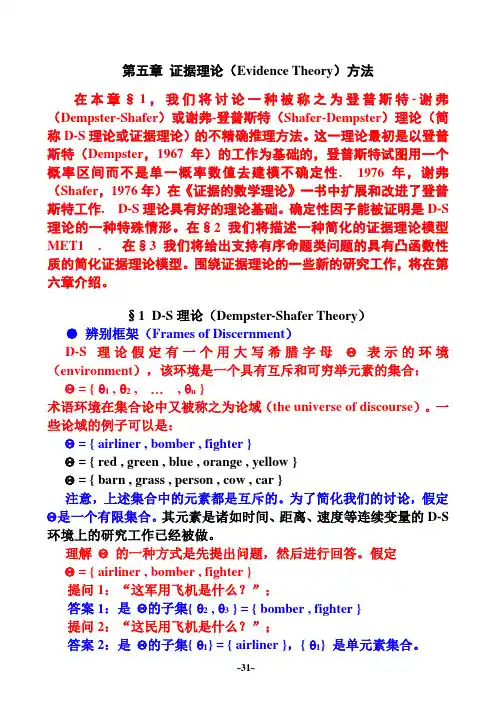
第五章证据理论(Evidence Theory)方法在本章§1,我们将讨论一种被称之为登普斯特-谢弗(Dempster-Shafer)或谢弗-登普斯特(Shafer-Dempster)理论(简称D-S理论或证据理论)的不精确推理方法。
这一理论最初是以登普斯特(Dempster,1967年)的工作为基础的,登普斯特试图用一个概率区间而不是单一概率数值去建模不确定性. 1976年,谢弗(Shafer,1976年)在《证据的数学理论》一书中扩展和改进了登普斯特工作. D-S理论具有好的理论基础。
确定性因子能被证明是D-S 理论的一种特殊情形。
在§2我们将描述一种简化的证据理论模型MET1 . 在§3我们将给出支持有序命题类问题的具有凸函数性质的简化证据理论模型。
围绕证据理论的一些新的研究工作,将在第六章介绍。
§1D-S理论(Dempster-Shafer Theory)●辨别框架(Frames of Discernment)D-S理论假定有一个用大写希腊字母Θ表示的环境(environment),该环境是一个具有互斥和可穷举元素的集合:Θ = { θ1 , θ2 , ⋯, θn }术语环境在集合论中又被称之为论域(the universe of discourse)。
一些论域的例子可以是:Θ = { airliner , bomber , fighter }Θ = { red , green , blue , orange , yellow }Θ = { barn , grass , person , cow , car }注意,上述集合中的元素都是互斥的。
为了简化我们的讨论,假定Θ是一个有限集合。
其元素是诸如时间、距离、速度等连续变量的D-S 环境上的研究工作已经被做。
理解Θ的一种方式是先提出问题,然后进行回答。
假定Θ = { airliner , bomber , fighter }提问1:“这军用飞机是什么?”;答案1:是Θ的子集{ θ2 , θ3 } = { bomber , fighter }提问2:“这民用飞机是什么?”;答案2:是Θ的子集{ θ1} = { airliner },{ θ1} 是单元素集合。
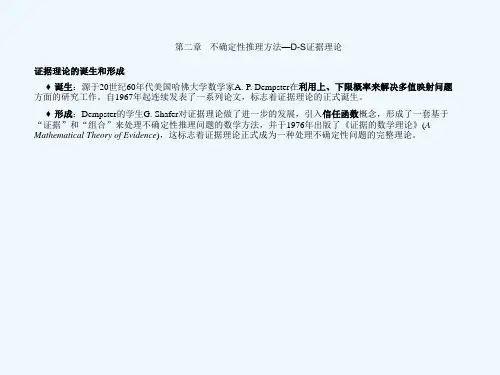
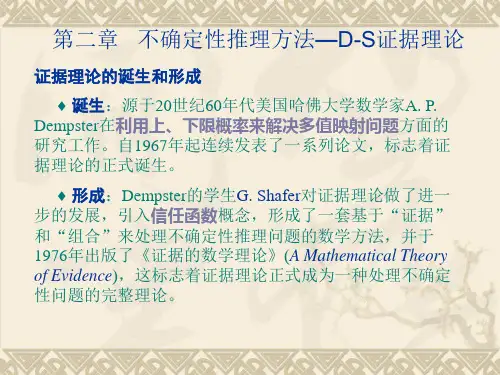
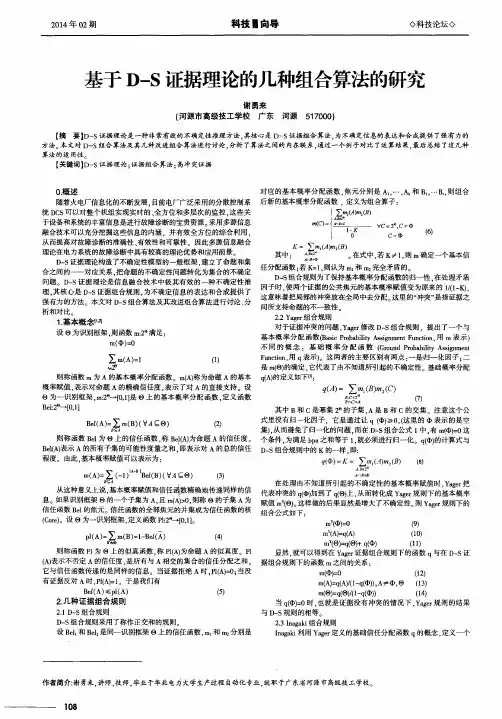

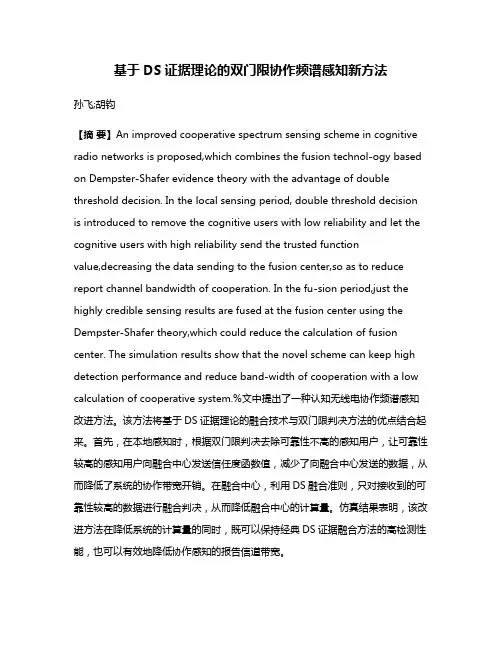
基于DS证据理论的双门限协作频谱感知新方法孙飞;胡钧【摘要】An improved cooperative spectrum sensing scheme in cognitive radio networks is proposed,which combines the fusion technol-ogy based on Dempster-Shafer evidence theory with the advantage of double threshold decision. In the local sensing period, double threshold decision is introduced to remove the cognitive users with low reliability and let the cognitive users with high reliability send the trusted functionvalue,decreasing the data sending to the fusion center,so as to reduce report channel bandwidth of cooperation. In the fu-sion period,just the highly credible sensing results are fused at the fusion center using the Dempster-Shafer theory,which could reduce the calculation of fusion center. The simulation results show that the novel scheme can keep high detection performance and reduce band-width of cooperation with a low calculation of cooperative system.%文中提出了一种认知无线电协作频谱感知改进方法。
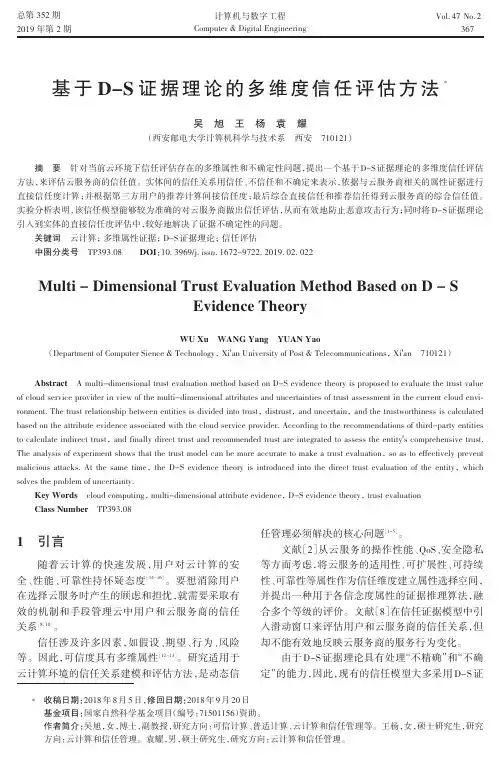
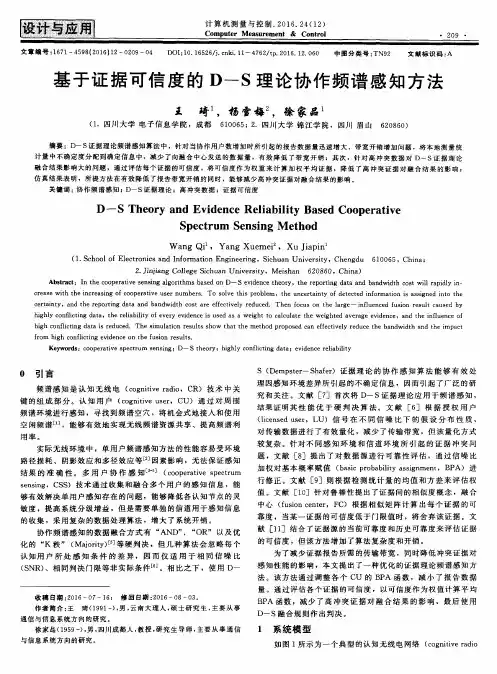
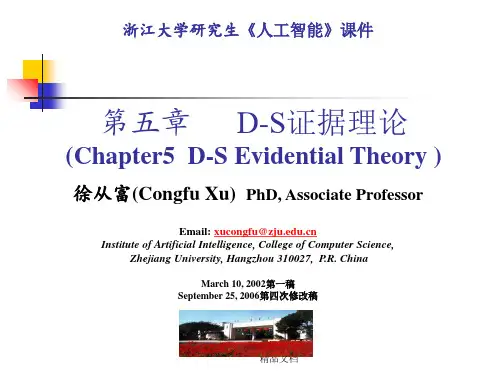
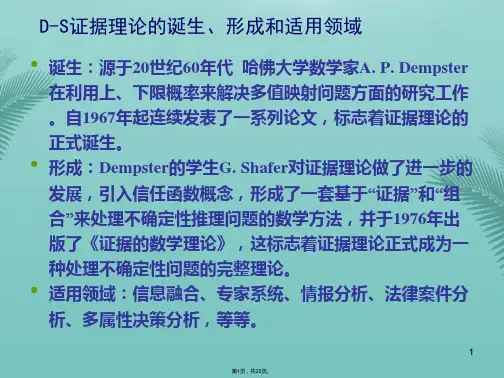

系统工程与电子技术SYSTEMS ENGINEERING ANDELECTRONICS1999 Vol.21 No.12 P.92-94D-S证据理论中的证据组合杜文吉 谢维信 摘 要 Dempster证据组合规则在D-S证据理论中将几组相互独立的证据融合,得到一组新的证据。
Dempster证据组合规则在D-S证据理论中起着十分重要的作用。
在对Dempster证据组合规则进行分析的基础上,提出了一组更加一般化的证据组合规则,即证据的逻辑运算及基于相似性加权的证据组合规则。
它们具有与Dempster证据组合规则不同的性质和应用背景。
主题词 置信界限 逻辑运算 信息交换 +证据组合 文章编号:1001-506X(1999)12-0092-03Evidence Combination Methods in D-S Evidence TheoryDu Wenji Xie Weixin(Xidian University, Electronic Engineering College,Xi'an 710071) Abstract Dempster's rule is used to combine probabilistically independent sets of evidence to improve the reliability or dependability of evidence information associated with different data sources. Dempster's rule plays a very important role in D-S evidence theory. Through analysis the property of the dempster's rule, we proposd some logic operation on sets of evidence, which is a much more generalized methods for combining probabilistically independent sets of evidence. A weighted dempster's rule of combination handling sets of evidence from various sources with different priority is also given, based on analysis of conjunctive combination defined by the min operation weighted by degree of consistency. Keywords Evidence theory Dempster combination rule Message suttching1 引 言 D-S证据理论[1]形成于60年代。
文章编号:1007-757X(2021)04-0148-03基于DS证据融合的学习者学习风格研究李强(东北石油大学计算机与信息技术学院,黑龙江大庆163318)摘要:为了在网络学习系统中通过分析学习行为来推测不同学习者学习的风格,提出了一种将BP神经网络和DS证据理论结合起来进行学习风格推测的方法。
以BP神经网络为基本推理模型,确定各证据的基本概率分配,利用DS证据理论的组合规则对BP的输出结果进行处理,以此来提高推测的准确度。
通过对某高校部分学生学习行为的分析结果表明,该方法能够有效地对学习者进行学习风格的推测,有助于网络学习系统达到个性化教学的目的。
关键词:BP神经网络;DS证据理论;学习风格中图分类号:TP311文献标志码:AResearch on Learner Learning Styles Based on DS Evidence FusionLIQiang(School of Computer and Information Technology,Northeast Petroleum University,Daqing163318,China)Abstract:To analyze the learning behaviors of learners in the online learning system,infer the learning style of different learners,this paper proposes a method for inferring learning style by combining BP neural network and DS evidence theory.This method uses BP neural network as the basic reasoning model,determines the basic probability distribution of each evidence,uses t h e combination rule of DS evidence theory to deal w i th the ou t p u t of BP,which improves t h e accuracy of the es t i m a t i on. Analysis of the learning behavior of some s t u den t s in a univers i t y shows tha t this me t hod can eCfectively infer the learning s t y le of learners,it helps t h e ne t w ork learning sys t c m to achieve t h e purpose of personalized t c aching.Key words:BP neural ne t work;DS evidence theory;learning s t y le0引言伴随着网络、信息以及计算机技术的不断发展和更新,学习者的学习模式也逐步从传统模式演变为在线模式,也就是常说的网络学习[门。
基于区间数的DS证据合成方法研究
叶清;吴晓平;郭正东
【期刊名称】《海军工程大学学报》
【年(卷),期】2009(021)002
【摘要】在DS证据理论的应用过程中,命题的基本概率赋值函数起到了关键的作用,传统DS证据理论中基本概率赋值函数的取值为[0,1]中的单点值.在很难准确将证据所支持命题的基本概率赋值表示为[0,1]之间的单点值时,可以用区间数形式来表示命题的基本概率赋值.在建立符合运算封闭性的区间数广义求和与广义乘积算子的基础上,定义了基于区间数的基本概率赋值函数、信任函数以及似然函数等重要概念,给出了证据合成规则,进而提出了基于区间数的DS证据合成方法.计算实例表明,与传统DS证据合成方法相比,基于区间数的DS证据合成方法具有更灵活的应用特性和更小的计算复杂度.
【总页数】6页(P1-5,11)
【作者】叶清;吴晓平;郭正东
【作者单位】海军工程大学,电子工程学院,武汉,430033;海军工程大学,电子工程学院,武汉,430033;海军潜艇学院,山东,青岛,266071
【正文语种】中文
【中图分类】TP18
【相关文献】
1.基于Landsat8数据的近海养殖区自动提取方法研究 [J], 武易天;陈甫;马勇;刘建波;李信鹏
2.基于Landsat8-OLI遥感影像水稻种植区提取方法研究 [J], 李孟倩;苏世宗
3.基于Landsat8-OLI遥感影像水稻种植区提取方法研究 [J], 李孟倩;苏世宗;
4.基于Landsat TM数据的黄土高原区水体识别方法研究 [J], 程磊;徐宗学;左德鹏;李林涛
5.基于NPP/VIIRS与Landsat-8数据对城市建成区提取方法研究 [J], 万继康
因版权原因,仅展示原文概要,查看原文内容请购买。